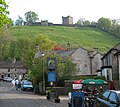Castleton, Derbyshire
| Castleton | |
| Derbyshire | |
|---|---|
 Castleton | |
| Location | |
| Location: | 53°20’38"N, 1°46’30"W |
| Data | |
| Population: | 649 (2001) |
| Post town: | Hope Valley |
| Postcode: | S33 |
| Dialling code: | 01433 |
| Local Government | |
| Council: | High Peak |
| Parliamentary constituency: |
High Peak |
Castleton is a gorgeous village in Derbyshire, within the Peak District. The village stands at the western end of the Hope Valley between the areas known as the Dark Peak (to the north) and the White Peak (to the south). It stands on the Peakshole Water, a tributary of the River Noe.
Castleton's population was 649 according to the 2001 census. It swells in the summertime as tourists flock in to see the village and the surrounding fells.
Geography
Castleton is situated between the gritstone plateau of the Dark Peak to the north and the gentler limestone scenery of the White Peak to the south. It lies at the western end of the Hope Valley and consequently is surrounded on three sides by hills. Most prominent is the ridge to the north. This is called Great Ridge; it runs east from Mam Tor to Back Tor and Lose Hill, by way of the pass (hause) of Hollins Cross, where paths from many directions converge and cross over to Edale.
History

Castleton village was mentioned as Pechesers in Domesday Book in 1086 where "Arnbiorn and Hundingr held the land of William Peverel's castle in Castleton".[1] This land and Peverel's castle were amongst the manors belonging to William Peverel that also included Bolsover and Glapwell.
St Edmund's Norman church was restored about 1837. It has late 13th-century tracery and an ashlar-faced Perpendicular tower. Its box pews are dated 1661, 1662, 1663 and 1676.[2]
A mediæval leper hospital (the Hospital of Saint Mary in the Peak) is thought to have been on the eastern boundary of Castleton, though some locals believe it to have been just south of the Speedwell Cavern footpath from the village. Sheffield University archaeologists are investigating 'Castle of the Peak', which was reputedly founded by the wife of one of the William Peverels before 1153, and continued until about the 1543 Dissolution. They say the earliest documents referring to Spital Field are a grant and a Charter from the early 14th century. They are also investigating the 12th-century planned town at the foot of the castle hill.[3]
Castleton later prospered from lead mining; the Odin Mine, one of the oldest lead mines in the country, is a mile west of the village. This industry created and enlarged local caverns, four of which are now open to the public as the Blue John Cavern, Speedwell Cavern, Treak Cliff Cavern and the Devil's Arse. A small amount of Blue John is mined locally.
Since the 1920s the main mineral industry in the area has been cement. Hope Cement Works is closer to Hope, but its quarry is closer to Castleton.
Pictures
-
Peveril Castle dominates the southern Castleton skyline
-
The Castle Hotel
-
The Three Roofs Café
-
The school in Castleton
-
The Castleton Garland King and his consort
-
Mam Tor towers above the main street of Castleton

Tourism
Castleton attracts large numbers of tourists, and there are many pubs (some with accommodation), tea shops and guest houses to supply their needs. There is also a large car park, an information centre, several outdoors shops and a youth hostel]]. Many schools visit the area for educational studies such as GCSE coursework. It is also a major walking centre, where routes up Cave Dale, Winnats Pass, Mam Tor and Hollins Cross meet. There are four "show caves" to visit (one of them by boat) and at least one of them is open all year. Castleton has a combined post office and general shop.
Events
On Castleton Garland Day (Oak Apple Day – 29 May), a Garland King is paraded around the streets wearing an extremely large garland of flowers,[4] followed by local girls dressed in white with flowers. The village is also famous for its display of Christmas lights and decorations during the festive season.
Walking
Castleton is popular with walkers: there is plenty of accommodation, and there are many public footpaths leading from the village. There are easy walks along the river to Hope, Brough, Bamford and (rather further) Hathersage, and there is a short strenuous walk up onto the Great Ridge, where views can be enjoyed before descending to Edale or returning to Castleton. Hayfield is a short day's walk away beyond Rushup Edge. A two- or three-day trail, the Limestone Way, starts in Castleton and runs south down Cave Dale (past the rear of the castle) before climbing out of the village and heading for Monyash, Youlgreave, and Matlock.
In fiction
- The Devil is an Ass, a play by Ben Jonson first performed in 1616 features Castleton.
- The 1990 BBC adaptation of The Silver Chair (one of C S Lewis's Narnia books) used the local underground caves as the filming location for the underworld, ruled by the evil Lady of the Green Kirtle.[5]
- The Princess Bride (1987) used Cave Dale as a location
- The Other Boleyn Girl (2008) also used Cave Dale
Outside links
| ("Wikimedia Commons" has material about Castleton, Derbyshire) |
- Derbyshire Guide
- Pigot's 1835 Directory
- maps, photos and descriptions of mineral localities around Castleton
- Castleton, Derbyshire
- Caves in Castleton, Derbyshire
References
- ↑ Domesday Book: A Complete Translation. London: Penguin, 2003. ISBN 0-14-143994-7 p.750
- ↑ Pevsner, Nikolaus (1978). The Buildings of England: Derbyshire. revised Elizabeth Williamson. Penguin Books. ISBN 0-14-071008-6.
- ↑ http://www.sheffield.ac.uk/archaeology/fieldwork/castleton
- ↑ Roy Hattersley on Oak Apple Day Daily Mail 2007
- ↑ The Silver Chair - locations on the Internet Movie Database





